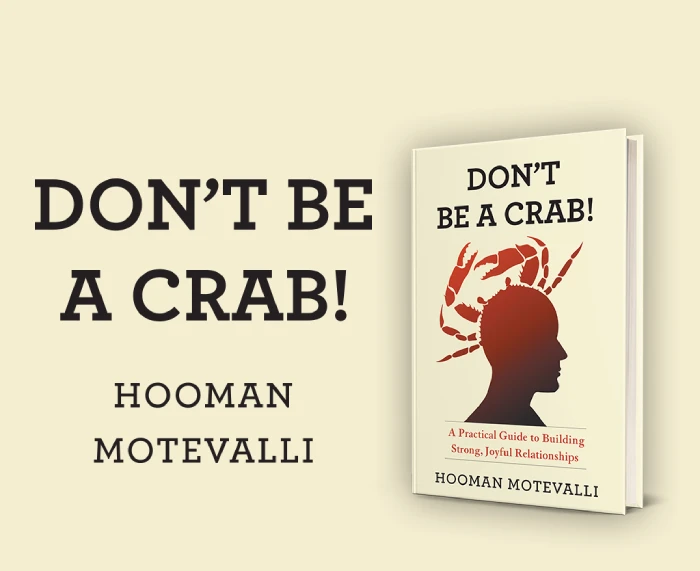The words we speak to others and ourselves have the power to change our lives. The things you think about and the words you speak have the ability to condition your mind toward success or failure. Every day, your self-talk influences how you interact with the world and the decisions you make. Even now, as you read this, a conversation is unfolding in your mind.
In Hooman Motevalli‘s novel “Don’t Be a Crab,” he explains how these internal conversations shape our lives. It’s the internal guide that directs our life in the right direction or in the wrong direction. Every self-talk wires our mind in two ways positive or negative, to be sad or happy, be grateful or worried, believe in yourself or look down on yourself.
What is positive self-talk?
It is the inner voice that encourages resilience, optimism, and self-confidence. It is the voice that inspires us to have faith in our own skills, see the positive side of things, and keep going when things get tough. It’s the “roommate” in your head that cheers you on, makes you feel good, and stands by you.
Positive self-talk is a powerful tool that helps us move away from self-criticism and focus on self-encouragement. It’s about training our inner dialogue to be constructive, uplifting, and aligned with our goals. However, for many, negative thoughts often take center stage, leading to self-doubt and emotional stress. A 2005 National Science Foundation Study estimated that 80% of our daily thoughts are negative.
At the end of this blog post, you’ll have learned how to feed your mind daily with powerful positive thoughts and replace the draining negative thoughts. We’ll be looking at important concepts in Hooman’s book to help you cultivate a strong habit of empowering and positive self-talk.
Practical Techniques to Reframe Negative Thoughts
Many of us are so accustomed to our internal dialogue that we barely register it. By bringing mindful attention to our thoughts, we start to recognize patterns. Do we default to self-criticism when faced with challenges? Jump to worst-case scenarios?
Here are three practical techniques for reframing negative thoughts, inspired by “Don’t Be A Crab.”
Reframing: Positive vs. Negative Self-Talk
You can begin actively rephrasing your self-talk once you become conscious of it. This involves evaluating the accuracy and usefulness of those negative thoughts and intentionally replacing them with more balanced, positive, and constructive messages. In his book, Hooman refers to this as the analyzer stage.
- Replace “I’m not good enough” with “I’m learning and improving every day.”
- Instead of saying, “I failed,” try, “This was an opportunity to grow.”
- Replace “I can’t do this” with “This is challenging, but I can figure it out step by step.”
- Instead of “I always mess things up,” try “I’m learning from my mistakes and doing better each time.”
- Replace “I’ll never succeed” with “Success takes time, and I’m progressing toward my goals.”
- Instead of “I’m such a burden,” try “I deserve support, just like everyone else.”
- Replace “Nothing ever works out for me” with “I’ve overcome challenges before, and I can do it again.”
- Instead of “I’m terrible at this,” try “I’m still practicing, and that’s how I’ll improve.”
- Replace “I should have done better” with “I did my best with what I knew at the time.”
- Replace “I’m not as talented as they are” with “Everyone has their strengths, and I’m focusing on my own growth.”
A 2021 study found that positive self-talk can significantly improve anxiety and reduce stress. By reframing your thoughts, you give yourself the permission to view challenges as opportunities rather than obstacles. For even faster results, discover how to shift negative self-talk in under 5 minutes. The goal is to develop a more cheerful, uplifting, and helpful inner dialogue.
This corresponds to the Distinguisher level of Don’t Be a Crab, where you recognize and challenge your inner voice. The book refers to this critical voice as the “Roommate,” and it frequently reacts due to fear or training. It’s a part of your mind that tries and frequently fails to protect you, not the true you.
Self-Compassion: How To Build Positive Thoughts
Consider your approach to a close friend who has made a mistake. Would you call them a failure, or would you reassure them? Most likely, you’d offer encouragement and remind them of their strengths. Self-compassion means offering yourself the same kindness.
Here’s how you can practice self-compassion when self-criticism arises:
- Acknowledge your feelings: “It’s okay to feel upset; this is a tough moment.”
- Reassure yourself: “It’s okay to make mistakes; I’m human.”
- Affirm your effort: “I’m doing my best, and that’s enough.”
- Offer yourself encouragement: “I’ve handled difficult situations before, and I can handle this too.”
- Normalize imperfection: “Nobody gets everything right all the time, and that’s okay.”
- Focus on progress: “Every step forward, no matter how small, is still progress.”
- Be patient with yourself: “Growth takes time; I don’t have to rush.”
- Appreciate your strengths: “I have unique qualities that help me in my journey.”
- Validate your emotions: “It’s normal to feel this way; I’m allowed to experience these feelings.”
- Focus on learning: “This experience is teaching me something valuable for the future.”
- Express gratitude for your effort: “I’m proud of myself for trying, even when it’s hard.”
A study by Dr. Kristin Neff, a pioneer in self-compassion, shows that it’s linked to greater happiness, emotional resilience, and better relationships. When you’re struggling, instead of thinking you’re weak and judging yourself harshly, offer yourself gentleness and patience.
In Don’t Be A Crab, Hooman mentions how self-compassion is crucial during the manager stage, where you actively manage the tone of your inner dialogue. This stage helps you take control of the roommate’s negative thoughts and shift toward positive self-talk.
Mindful Observation: How To Overcome Negative Thoughts
Observe your thoughts mindfully, without reacting to them or succumbing to their emotional pull. Think of those thoughts like floaty clouds in the sky. You just let them go by without attempting to manage or pursue them.
Hooman calls this the observer stage, where you begin noticing the constant chatter of your inner voice. This is not to stop the conversation, but to recognize it as just thoughts. For example, when you catch yourself thinking, “I always mess things up,” don’t fight the thought or agree with it. Instead, acknowledge it: “There’s that thought again.” Then let it drift away.
Hooman offers practical techniques like:
- Fixed short phrases: Create go-to phrases to counter negative self-talk. When your inner critic pipes up, you might respond with an affirmation like, “I am capable and worthy, even when facing challenges.” By repeatedly redirecting your self-talk, we train our minds to default to a more supportive, growth-oriented perspective.
- Talk Check: Deepen your awareness of recurring patterns in your thinking. Write down your self-talk word-for-word to identify how certain situations trigger specific thoughts. Over time, you’ll see these patterns more clearly and understand when your mind is speaking out of habit or fear.
- Three-Second Rule: Pause for three seconds before responding to any situation. This brief pause gives you a chance to notice your inner dialogue, assess whether it’s helpful, and decide how to proceed.
- Thumb in Fist. When you find yourself in a stressful moment, subtly make a fist and place your thumb inside. This small physical gesture serves as a reminder to check in with your thoughts and emotions, creating a space for observation instead of reaction.
A 2012 study found that mindfulness reduced negative emotions, improved focus and memory, reduced aggressive emotional reactions and increased relationship satisfaction. The ultimate goal, which Hooman calls the manager stage, is to proactively steer our self-talk in a positive direction. This doesn’t mean suppressing negative thoughts altogether. Rather, it’s about developing the skill to notice them and consciously shift to a more positive train of thought.
Conclusion
Changing the way we talk to ourselves is a continuous process rather than a quick fix. Our cognitive patterns, often deeply rooted, are the result of years of experiences and ideas. To change people for the better, you’ve got to keep trying. However, as Hooman points out, the benefits are profound. By learning to be our own ally and mentor, we tap into a powerful source of inner strength and resilience.
Our relationships improve as we extend the same compassionate understanding to others that we’re cultivating within ourselves. In the end, reframing our negative thoughts becomes a catalyst for personal transformation, enabling us to approach life with greater clarity, confidence, and grace.
In essence, “Don’t Be a Crab” offers a compelling case for the transformative power of positive self-talk. By providing a clear framework and practical tools for reshaping our inner dialogue, Hooman empowers readers to become the conscious architects of their mental landscape. By learning to observe, analyze, and redirect our self-talk, we can achieve profound personal growth, one thought at a time.






